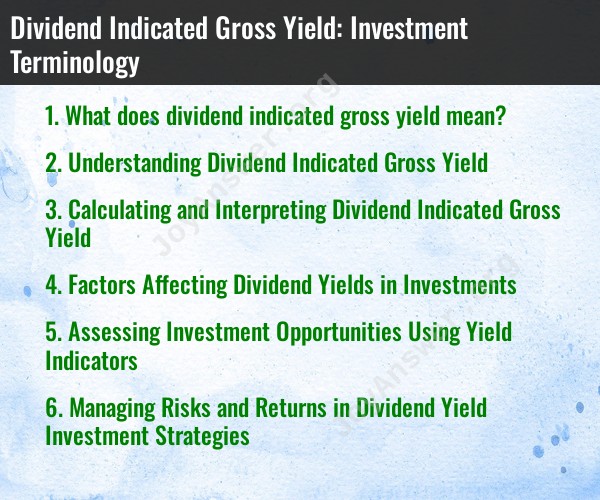What does dividend indicated gross yield mean?
The Dividend Indicated Gross Yield (DIGY), also known as the Dividend Yield, is a financial metric used in the context of investing, particularly in stocks and real estate investment trusts (REITs). It represents the annual dividend income generated by an investment relative to its market price. In other words, it calculates the yield or return that an investor can expect to receive from dividends as a percentage of the investment's current market value.
The formula for calculating the Dividend Indicated Gross Yield is as follows:
Here's a breakdown of the components of this formula:
Annual Dividends per Share: This is the total annual dividend payment that an investor receives for each share of the investment. It's typically based on the most recent dividend payment and can vary from one period to another.
Current Market Price per Share: This is the current trading price of the investment per share in the market. It reflects the supply and demand for the investment and can fluctuate over time.
The result of this calculation is expressed as a percentage, making it easier to compare different investments and assess their income potential.
The Dividend Indicated Gross Yield is a useful tool for investors seeking income from their investments. A higher DIGY indicates a relatively higher income potential compared to the investment's market price, which can be attractive for income-focused investors. However, it's essential to consider other factors, such as the sustainability of dividends and the overall financial health of the investment, before making investment decisions based solely on the dividend yield.
Understanding Dividend Indicated Gross Yield
Dividend indicated gross yield (DIGY) is a financial ratio that measures the annual dividend income earned on a stock as a percentage of its current market price. It is calculated by dividing the annual dividend per share by the current stock price.
DIGY = (Annual dividend per share / Current stock price) * 100%
DIGY is a useful measure for comparing the dividend yields of different stocks. It can also be used to track the dividend yield of a single stock over time.
Calculating and Interpreting Dividend Indicated Gross Yield
To calculate DIGY, simply divide the annual dividend per share by the current stock price and multiply by 100%. For example, if a stock has an annual dividend per share of $2 and a current stock price of $50, the DIGY would be 4%.
DIGY can be interpreted as follows:
- A higher DIGY indicates a higher dividend yield, meaning that the stock is paying out a larger percentage of its earnings to shareholders.
- A lower DIGY indicates a lower dividend yield, meaning that the stock is paying out a smaller percentage of its earnings to shareholders.
Factors Affecting Dividend Yields in Investments
A variety of factors can affect the dividend yield of a stock, including:
- Company profitability: Companies that are more profitable are more likely to pay out dividends to shareholders.
- Company growth: Companies that are growing rapidly are more likely to reinvest their earnings back into the business rather than paying them out as dividends.
- Industry: Some industries, such as utilities and consumer staples, are known for paying higher dividends than others.
- Interest rates: When interest rates are low, investors are more likely to invest in dividend-paying stocks, which can drive up dividend yields.
Assessing Investment Opportunities Using Yield Indicators
DIGY can be used to assess investment opportunities in a variety of ways. For example, investors can use DIGY to:
- Compare the dividend yields of different stocks within the same industry.
- Identify stocks that are offering high dividend yields relative to their historical averages.
- Track the dividend yields of their portfolio stocks over time to ensure that they are still meeting their investment goals.
Managing Risks and Returns in Dividend Yield Investment Strategies
While dividend-paying stocks can offer investors a steady stream of income, it is important to remember that all investments carry risk. Some of the risks associated with dividend yield investment strategies include:
- Dividend cuts: Companies can cut or eliminate their dividends at any time.
- Stock price volatility: Stock prices can fluctuate wildly, which can impact the value of an investor's portfolio.
- Reinvestment risk: Investors who reinvest their dividends back into the same stock could lose money if the stock price declines.
To manage the risks associated with dividend yield investment strategies, investors should:
- Diversify their portfolio by investing in a variety of dividend-paying stocks from different industries.
- Rebalance their portfolio regularly to ensure that it remains aligned with their investment goals and risk tolerance.
- Consider investing in dividend-paying ETFs or mutual funds, which offer a more diversified way to invest in dividend-paying stocks.
Overall, DIGY is a useful tool for investors who are considering dividend-paying stocks. By understanding how to calculate and interpret DIGY, investors can better assess investment opportunities and manage the risks and returns associated with dividend yield investment strategies.










